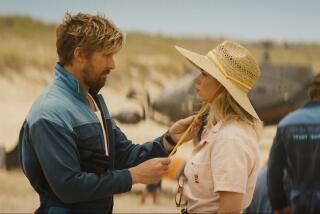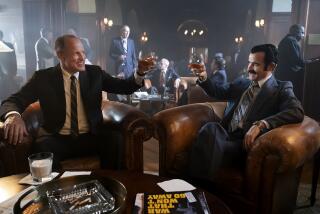After ‘Waterworld,’ a ‘Cable’ Lifeboat
- Share via
It’s mere coincidence that producers Andy Licht and Jeff Mueller found both the script for “Waterworld” and the upcoming Jim Carrey comedy “The Cable Guy.” But the road these projects then traveled from small or modestly budgeted films to major big-budget features is practically a textbook testament of how the studio system works today.
Licht and Mueller, both USC film school graduates, had started small with two low-budget features, the teen comedy “License to Drive” and the family film “Little Monsters.” Then, one day, a bigger action script called “Waterworld”--by a younger writer/director, Peter Rader--came across their desk. “We saw it basically as a spaghetti Western on water,” Mueller says.
Pairing up with producer John Davis, with whom they’d worked on “License to Drive,” the script was submitted to studios on Dec. 23, 1988, as a modestly budgeted ($30-million) action film. After it was picked up by Larry Gordon, then head of Largo Pictures, Mueller and Licht worked with young Scandinavian director Nils Gaup (“Pathfinder”) at devising a feasible budget.
“We had mapped out several ways of keeping it under control,” Licht adds. It may sound like 20-20 hindsight in light of what eventually happened on “Waterworld,” but Licht and Mueller claimed they had a way to keep the budget from spiraling, always a danger when filming on water.
These included building docks on both sides of the floating set so all the crew would be on terra firma and the set would be moored between two fixed points. They had also decided on the comparatively milder seas of the Caribbean, or possibly the large water tank in Malta that was recently used for the pirate movie “Cutthroat Island.”
But once Kevin Costner and director Kevin Reynolds came aboard, they say, their input was not only unheeded, but they say they were not-so-politely asked to leave the picture. “We got a call from one executive who said that if we did not play along with CAA and Universal, neither company would ever do business with us again,” Licht says.
Every entertainment lawyer they tried to put on the case eventually backed off. Licht finally turned to his semi-retired lawyer father, David, who secured them 150% of their fee and executive producer credits.
In retrospect, both Licht and Mueller realize they were saved a lot of headaches and the possibility of being fall guys in the ensuing negative publicity.
In the meantime, having turned their attention away from development while concentrating on “Waterworld,” they were eager to get back into production when a first script from Lou Holtz Jr., a county prosecutor from Norwalk, came across their desk.
It was a comedy about a cable repairman who invades people’s lives and the mayhem that ensues.
“ ‘The Cable Guy’ was the perfect $3-million to $5-million independent comedy,” Mueller says. Their immediate cast choices ranged from comics like “Saturday Night Live” veteran Chris Farley as well as Kevin Meany, Andrew Clay and Chris Elliott.
When Farley became interested, he was attached to the project. The script went out to studios right after Farley’s “Tommy Boy” opened and, according to Licht, “every studio wanted it because it wasn’t expensive.”
By now, the budget was about $8.5 million--because of studio involvement. They almost lost Farley to a TriStar project and when that fell apart, Paramount had locked him into another comedy called “Black Sheep” and wouldn’t shake him loose. Since Farley was then due to return to “Saturday Night Live,” that meant a year’s delay. (Farley has since decided not to return to the NBC show).
But Columbia Pictures’ Mark Canton, who bought “The Cable Guy,” wanted it for summer of 1996. And Jim Carrey was available. And he wanted to do it. And Columbia was willing to pay him $20 million for his services.
Production begins Dec. 4 on “The Cable Guy,” now budgeted at around $40 million. Licht and Mueller will be the producers of record.
More to Read
Only good movies
Get the Indie Focus newsletter, Mark Olsen's weekly guide to the world of cinema.
You may occasionally receive promotional content from the Los Angeles Times.









